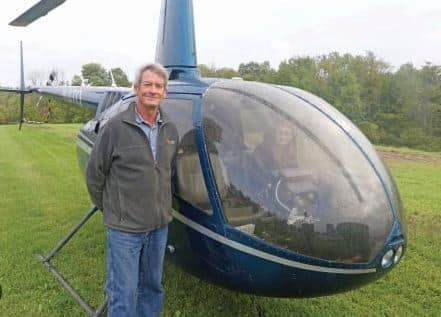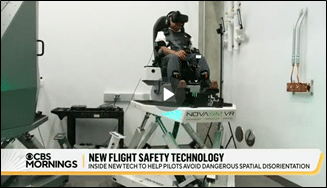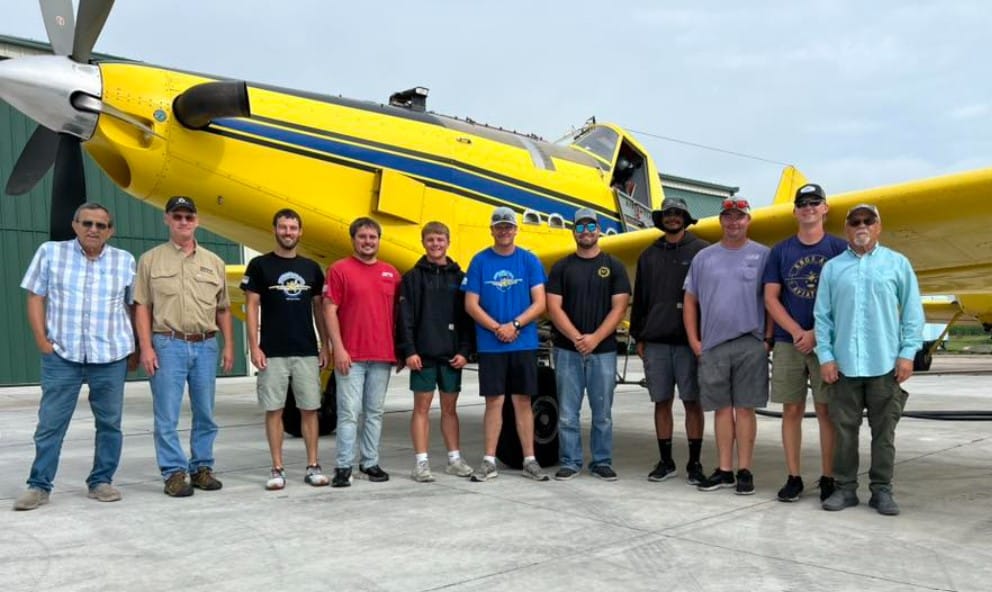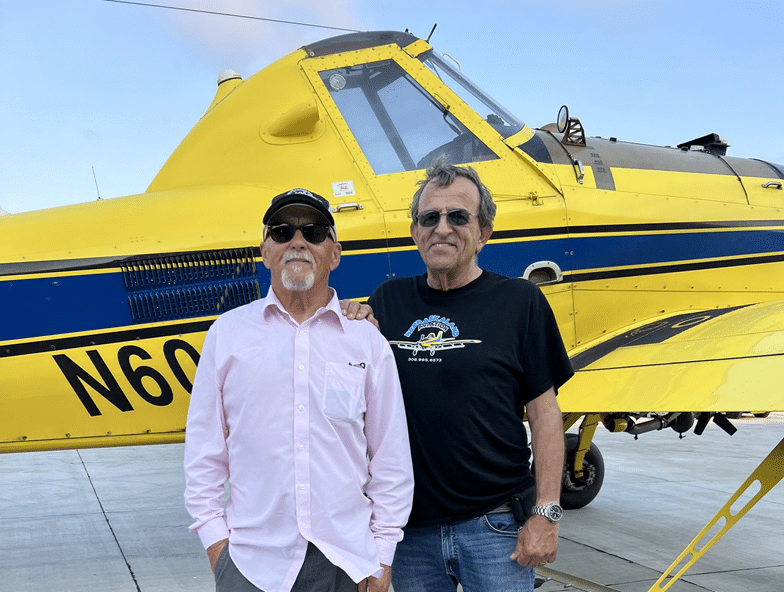Click on the article title below to be taken directly to the article. After you’re done reading the article, click “Back to Top” at the bottom to be brought back to the Table of Contents.
Table of Contents
- FAA Releases Proposed Rule for Drone BVLOS Operations – 14 CFR Part 108 – at Crewed Aircraft’s Peril
- Lawsuit Covering Ag Aviation Customer Liability for Withholding Safety Information to be Heard by Jury; RFD-TV Covers Court Ruling
- New Anti-Disorientation Technology Could Benefit Ag Pilots in the Future
- Nebraskaland Aviation Celebrates Two Pilot Retirements with Combined 95 Years of Service
- Alexander Leamon Lost in Third Fatal Ag Accident of 2025 Season
- Stanley Joseph Hebert Jr. Fatally Injured in Fourth Fatal Ag Accident of 2025
- 2025 Ag Aviation Golf Tournament Oct. 18-19
FAA Releases Proposed Rule for Drone BVLOS Operations – 14 CFR Part 108 – at Crewed Aircraft’s Peril
This week, FAA released the Draft Notice of Proposed Rulemaking (NPRM) for Beyond Visual Line of Sight (BVLOS) drone operations as well as a Fact Sheet describing some of the broad strokes of the NPRM. This was ahead of a Press Conference on “Unleashing American Drone Dominance,” wherein the NPRM was introduced. Many of its provisions severely endanger low-altitude crewed aircraft.
This NPRM would primarily establish a new part to Title 14 of the Code of Federal Regulations (14 CFR), namely Part 108 – Operations of Unmanned Aircraft Systems Beyond Visual Line of Sight. In establishing Part 108, it would also amend several other parts including Part 91, Part 107, Part 135 and Part 137. The document is over 700 pages and, while NAAA is still in the early stages of digesting it, some of the apparent substantive proposed changes are shared here.
In general, Part 108 would provide a regulatory framework for UAS operations (either VLOS or BVLOS) flying at 400 feet AGL or less. It introduces two tiers of operational authorization (permits and certificates) for operations such as package delivery, agriculture and aerial surveying. It proposes a new structure for operations personnel wherein airman certificates are not required, but each operator (both permitted and certificated) must have an operations supervisor responsible for the overall safety of the operation and a qualified flight coordinator responsible for tactical oversight of individual aircraft.
In terms of right-of-way, UAS operated under Part 108 (either VLOS or BVLOS) would have the right-of-way over all other aircraft – unless the other aircraft is broadcasting ADS-B Out or electronic conspicuity (EC), in which case a crewed/manned aircraft would have right-of-way. In defined “Shielded Areas,” such as within 50-feet of powerlines, UAS would have right-of-way over all other aircraft, regardless of ADS-B or EC. This provision is the most perilous to low-altitude crewed aviators, whether they be firelow-altitudefighters, ag aviation operations, law enforcement, EMS, and numerous helicopter operations. The 2022 FAA UAS BVLOS Aviation Rulemaking Committee proposed a 100-foot shielded area. NAAA adamantly opposed any type of shielded area to FAA Administrator Nolen and DOT Secretary Buttigieg at the time and will continue to do so, along with other low altitude crewed aviation interests, in comments to the FAA.
For agricultural UAS operations, both VLOS and BVLOS would be authorized, and the maximum weight of the UAS could not be greater than 1,320 pounds. Part 108 agricultural UAS operations would be entirely exempt from the requirements of Part 137 and instead would be subject to some similar requirements contained wholly within Part 108. Of peripheral interest will be the duty and rest requirements, which would impose a 50-hour duty week, amongst other restrictions.
There are obviously myriad other details which NAAA will need to process as it formulates a response to this NPRM. The right-of-way changes are the most dangerous prospect; NAAA had hoped for more about shared responsibility for see-and-avoid, rather than the full-throated granting of right-of-way to UAS over aircraft without ADS-B. However, NAAA will provide evidence-based comments to FAA on this issue and others contained in this NPRM. Hopefully, with input from NAAA and other general aviation associations, the Final Rule will not be as imperiling to the safety of low-altitude aviators.
Your help will be needed. Once NAAA’s comments are drafted, they will be shared with NAAA membership in the hopes that others in the industry will use them in submitting their own comments. This NPRM will soon be published in the Federal Register, at which time a 60-day comment window will begin.
For reference, below are some of the substantive proposed changes to 14 CFR as summarized by NAAA.
Part 43 – Maintenance, Preventative Maintenance, Rebuilding and Alteration
§43.1 Applicability
This part will not be applicable to Part 108 aircraft
Part 91 – General Operating and Flight Rules
§91.113 Right-of-way rules: Except water operations.
Part 108 UAS will have right-of-way over other aircraft in flight except for (1) over densely populated areas, or (2) in Class B or C airspace, or (3) when that aircraft is departing from or arriving at an airport or heliport, or (4) when that aircraft is equipped and broadcasting its location using ADS-B Out or electronic conspicuity equipment.
§91.225 Automatic Dependent Surveillance-Broadcast (ADS-B) Out equipment and use.
ADS-B equipped aircraft will NOT be required to have ADS-B in transmit mode at all times if the equipment is operated solely to meet the conspicuity requirements in §91.113. In other words, you can legally turn it off. However, if it is turned off, Part 108 UAS will have the right-of-way.
Part 108 – Operations of Unmanned Aircraft Systems Beyond Visual Line of Sight
§108.110 Unmanned aircraft lighting
UAS must be equipped with anti-collision lighting and keep them on during all flight operations.
(This is a provision that NAAA has been advocating for UAS for 12 years.)
§108.175 Operating restrictions.
UAS must stay under 400 feet AGL unless within a 400-foot radius of a structure in Class G airspace (which allows flying up to 400 feet above the structures uppermost limit).
§108.195 Operation near aircraft; low altitude right-of-way rules.
Unless operating in a shielded area (§108.205) UAS must yield the right of way to all aircraft that are (1) departing from or arriving at an airport or (2) Equipped and broadcasting their location using ADS-B or electronic conspicuity (EC).
§108.205 Operation in shielded areas.
Defines shielded areas as those “where no manned aircraft are expected to operate”, including areas within 50 feet of powerlines, railroad tracks, bridges and pipelines. In these areas, UAS will have right-of-way over all aircraft, regardless of ADS-B or EC.
§108.330 Duty and rest requirements.
Operations personnel are limited to a max 14-hour duty day, and to a maximum 50-hour duty week. They must take a minimum 10-hour continuous rest period within 24 hours prior to reporting for duty. They must also receive a minimum of one day of continuous rest (off work) per week.
§108.400 Operations under a permit.
Allows operations, such as package delivery, agriculture and aerial surveying, to be conducted under a new Permit framework, valid for 24 months, rather than an operator certificate.
§108.445 Agricultural operations.
Establishes rules for permit-based agricultural operations. These are limited to small companies (less than 10 aircraft) and to low population density areas.
§108.500 Operations under a certificate.
Allows operations, such as package delivery, agriculture and aerial surveying, to be conducted with a perpetual Part 108 certificate (in lieu of, for example, a Part 137 certificate). In contrast to “lower risk” permitted operations, certificated operations grant more privilege and consequently have more stringent requirements such as validation tests, communication and ground risk assessments, and a safety management systems.
§108.575 Agricultural operations.
Establishes rules for certificate-based agricultural operations. These do not have the same restrictions as permit-based agricultural operations.
§108.700 Airworthiness acceptance generally.
Prescribes procedures and standards for UAS airworthiness acceptance. The UAS must be manufactured in the US or a country with which the US has Bilateral Airworthiness Agreement addressing UAS. Subpart G (this subpart) and Subpart H which also deals with airworthiness acceptance is extensive and has not yet been reviewed by NAAA.
Part 137 – Agricultural Aircraft Operations
§137.1 Applicability
Excludes Part 108 aircraft from Part 137 applicability entirely
Lawsuit Covering Ag Aviation Customer Liability for Withholding Safety Information to be Heard by Jury; RFD-TV Covers Court Ruling

RFD-TV covered last month’s U.S. Court of Appeals for the Fourth Circuit ruling that the Kritter Cropdusting case, stemming from a fatal wire-strike crash, must go to a jury trial. RFD-TV anchor Suzanne Alexander interviewed Roger McEowen with the Washburn School of Law, who brought up the question of whether farmers and landowners should be required to disclose to an ag pilot if there are hazards in a field.
The lawsuit stems from the death of veteran Virginia ag pilot Eugene (Gene) Kritter, who was fatally injured on June 18, 2020. The helicopter he was piloting crashed just north of Goldsboro, North Carolina. The Robinson R66 helicopter struck a steel dove line while spraying corn.
His estate and Kritter Cropdusting sued Murry Rayborn Daw’s estate, Daw Farms, Nutrien Ag Solutions, and William Jordan Elmore, alleging negligence and other claims. The case was heard in the U.S. District Court for the Eastern District of North Carolina and issued a summary judgment—deciding the case without a full trial, determining that there are no genuine issues of material fact in dispute and that one party is entitled to judgment as a matter of law. On July 8, 2025, a three‑judge panel of the U.S. Court of Appeals for the Fourth Circuit issued a published opinion that vacated the district court’s dismissal and remanded the matter for a jury trial. The appeals court concluded that questions of fact remain, meaning it is not for a judge to decide as a matter of law. This includes factual disputes about negligence, foreseeability and duty regarding the visible hazards encountered by Kritter.
After the 2011 death of California ag pilot Stephen Allen, his family was awarded a subsequent legal settlement from tower companies and landowning interests for $6.7 million in damages due to his fatal injuries and not being informed by the defending parties of the location of an unmarked meteorological evaluation tower that he struck and was killed by.
NAAA will keep members informed about this case, Lynne Kritter v. Brent Mooring, No. 24-1158 (4th Cir. 2025), finding potential legal liability for aerial customers withholding key safety information from agricultural aviation operations.
Our thoughts are with Gene’s wife, Lynne, and their three daughters, Elena, Dani, and Josie.
New Anti-Disorientation Technology Could Benefit Ag Pilots in the Future

Spatial disorientation continues to be a major concern in aviation safety, responsible for 5% to 10% of general aviation accidents, and tragically, 90% of those incidents are fatal, according to the Federal Aviation Administration (FAA). Even seasoned pilots can fall victim when the body’s equilibrium and visual cues are in conflict.
For ag pilots, the risk of disorientation may not be as pronounced during typical daytime spraying operations, but low-altitude flying, busy schedules, fatigue and sudden weather shifts can all compound the danger, especially in marginal conditions.
The CBS Morning News recently reported on new research at the University of Maryland that may offer a promising advancement to help address this hazard. A team of engineers and aviation specialists is developing wearable technology that could help prevent spatial disorientation through the use of vibrations.
Similar in concept to the lane departure warning systems in cars, the prototype flight suit would deliver subtle vibrations to inform a pilot if the aircraft is banking, climbing or descending unexpectedly. By adding vibration alongside visual instruments and the body’s natural equilibrium, this system aims to guide pilots back to proper orientation when traditional senses become unreliable.
Helicopter pilot and aerospace engineering professor Anubhav Datta, along with professor Umberto Saetti, is leading the University of Maryland research project. They’re designing the system to work either as part of a flight suit or integrated into a pilot’s seat. Early testing shows promise in helping pilots ‘feel’ their orientation, especially in low-visibility conditions.
While this technology is still in development, the implications for agricultural aviation are worth watching. Ag pilots often operate in unique and demanding environments, and while they’re trained for visual flying in daylight, situations like sudden weather deterioration, obstruction avoidance, or transitioning between topography could present opportunities where additional sensory feedback could enhance safety.
The technology will need to be approved by the FAA. Read the article.
Nebraskaland Aviation Celebrates Two Pilot Retirements with Combined 95 Years of Service
Nebraskaland Aviation, an NAAA operator member based in Holdrege, NE, is celebrating the retirement of two veteran ag pilots with a combined 95 years and nearly 50,000 hours of flight experience.
Antonios “Tony the Greek” Drakoulakis retires after a 50-year, 27,000-hour career. Originally from the island of Chania, Crete, Greece, Tony earned his pilot’s license in Athens, Greece, and moved to the U.S. at 19 to pursue his aviation dreams. He began ag flying in Oklahoma in 1975 and worked across several states. After a brief return to Greece as a civilian firefighter with the Greek Air Force, he resumed ag flying in the U.S. and joined Nebraskaland Aviation in 2007. He now plans to return to Greece to enjoy retirement with his family.
Also retiring from Nebraskaland Aviation is Terry “Two Dogs” Nelson, who logged nearly 20,000 hours over a 45-year career. A Vietnam veteran and former helicopter Crew Chief, Nelson began ag flying in 1980, trained by his father, Paul Nelson, in South Dakota. He joined Nebraskaland Aviation in 1993 and flew across many Midwest states, earning a reputation for skill and dedication.
Both pilots flew their final loads last week and were welcomed back at the airport by friends and supporters. Both Nelson and Drakoulakis have demonstrated dedication, expertise, and steady presence in the cockpit which have left lasting legacies in the ag aviation industry. A celebration honoring Nelson and Drakoulakis will be held at Nebraskaland Aviation in late August.


Alexander Leamon Lost in Third Fatal Ag Accident of 2025 Season

Alexander Paul Leamon was fatally injured in an ag aviation accident on July 22, 2025, in Oregon, Illinois. He was born on April 11, 2002. After graduating from high school in 2020, he studied agronomy at Highland Community College before attending and graduating from an ag aviation training school.
Alex worked at a landscaping company in addition to his budding ag aviation career. He enjoyed numerous outdoor activities including hunting, fishing, and boating. Alex is survived by his parents, girlfriend, a brother and sister, grandparents, and numerous aunts, uncles, and cousins.
Alex’s visitation was held on Sunday July 27, 2025, at the Leamon Funeral Home in Lena, IL. Funeral services were held the next day at St. Joseph Catholic Church in Lena, IL, with burial at Lena Burial Park. Click here to read Alex’s full obituary. A memorial has been established in his name; contact Leamon Funeral Homes for more details.
The members and staff of NAAA extend their sympathies to Alex’s family and friends. Please keep his loved ones in your thoughts and prayers as they go through this difficult time.
Back to top
Stanley Joseph Hebert Jr. Fatally Injured in Fourth Fatal Ag Accident of 2025

The members and staff of NAAA offer their deepest sympathies and condolences to the family and friends of Stanley Joseph Hebert Jr. who was fatally injured in ag aviation accident on July 23, 2025, near Thibodaux, Louisiana. Born on January 3, 1958, he was 67 years old at the time of his passing.
Stanley was a pilot for 39 years, and during that time he mentored many young pilots as a certified flight instructor. He was a man of deep faith who loved his family and was devoted to their wellbeing. Stanley also enjoyed hunting and fishing and loved being outdoors. He is survived by his wife, two children, a grandson, three siblings, as well as extended family, friends, and his hunting dog.
Stanley’s visitation was held on Sunday, July 27, 2025, at the Vincent Funeral Home in Kaplan, Louisiana. His burial mass was held the following day at Our Lady of the Most Holy Rosary Roman Catholic Church. You can read his full obituary here. In lieu of flowers, please make donations to the Healing House, “Hope for grieving children” at 160 S Beadle Rd Lafayette, LA 70508. Please keep Stanley’s family and friends in your thoughts and prayers as they mourn his passing.
2025 Ag Aviation Golf Tournament Oct. 18-19

NAAA members are invited to join fellow Arkansas brethren for a fun-filled weekend of golf and fellowship on October 18–19. The Red Apple Inn and Country Club in Heber Springs, Arkansas, is hosting the 2025 Ag Aviation Golf Tournament.
The $200 entry fee covers two rounds of golf, happy hour and dinner at the Red Apple Inn and Country Club on Saturday evening. (A dinner-only fee of $50 is available for non-golfers.) The shotgun tournament starts at 9 a.m. Saturday, Oct. 18, with a two-person scramble format. The final round tees off Sunday, Oct. 19, with a shotgun start at 9 a.m.
Inn rooms and two-bedroom condos are available at the Red Apple Inn for $155 and $235/night, respectively. Call the Red Apple Inn at 1-800-733-2775 and use the reservation code “AG AVIATION” to reserve your room. To register for the 2025 Ag Aviation Golf Tournament, please complete the player registration form and mail it with a check payable to “Ag Aviation Golf Tournament” to:
Brenda Watts
120 Norris Lane
Watson, AR 71674
(870) 377-5241
Sponsorship opportunities are also available, including placing your name on a tee box or banner. Please refer to the sponsorship registration form for more information. A small group of Arkansas aerial applicators organizes the annual golf tournament. Each year the organizers donate the tournament’s proceeds to a different organization of their choosing. Proceeds from the 2025 tournament will be donated to the Last Pass Memorial Walk at the National Agricultural Aviation Museum (Mississippi Agriculture and Forestry Museum) in Jackson, MS and the Scott Rainey Memorial Scholarship.
In Case You Missed Last Week’s NAAA eNewsletter
Click here for the July 31, 2025 eNewsletter to read:
- Pesticide Litigation and Local Jurisdiction Efforts Advocated by Senator Cory Booker (D-NJ)
- Happy 104th Birthday Aerial Application Industry
- FAA’s GA Survey Data Collection for 2024 is Coming to a Close
- NAAA Award Nominations Due Tuesday, August 5
- AD Proposed for AStar Cargo Swing Emergency Release Control

